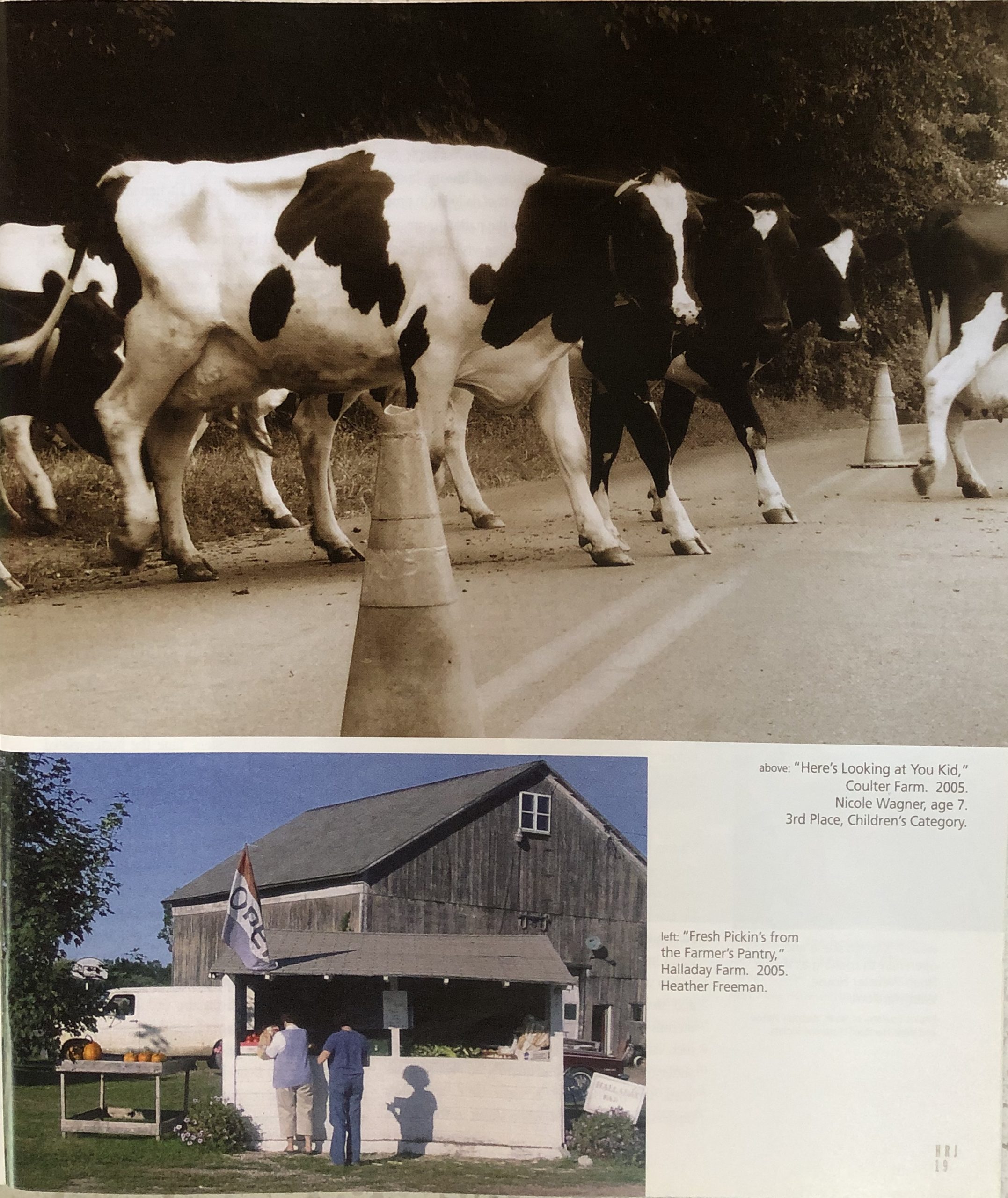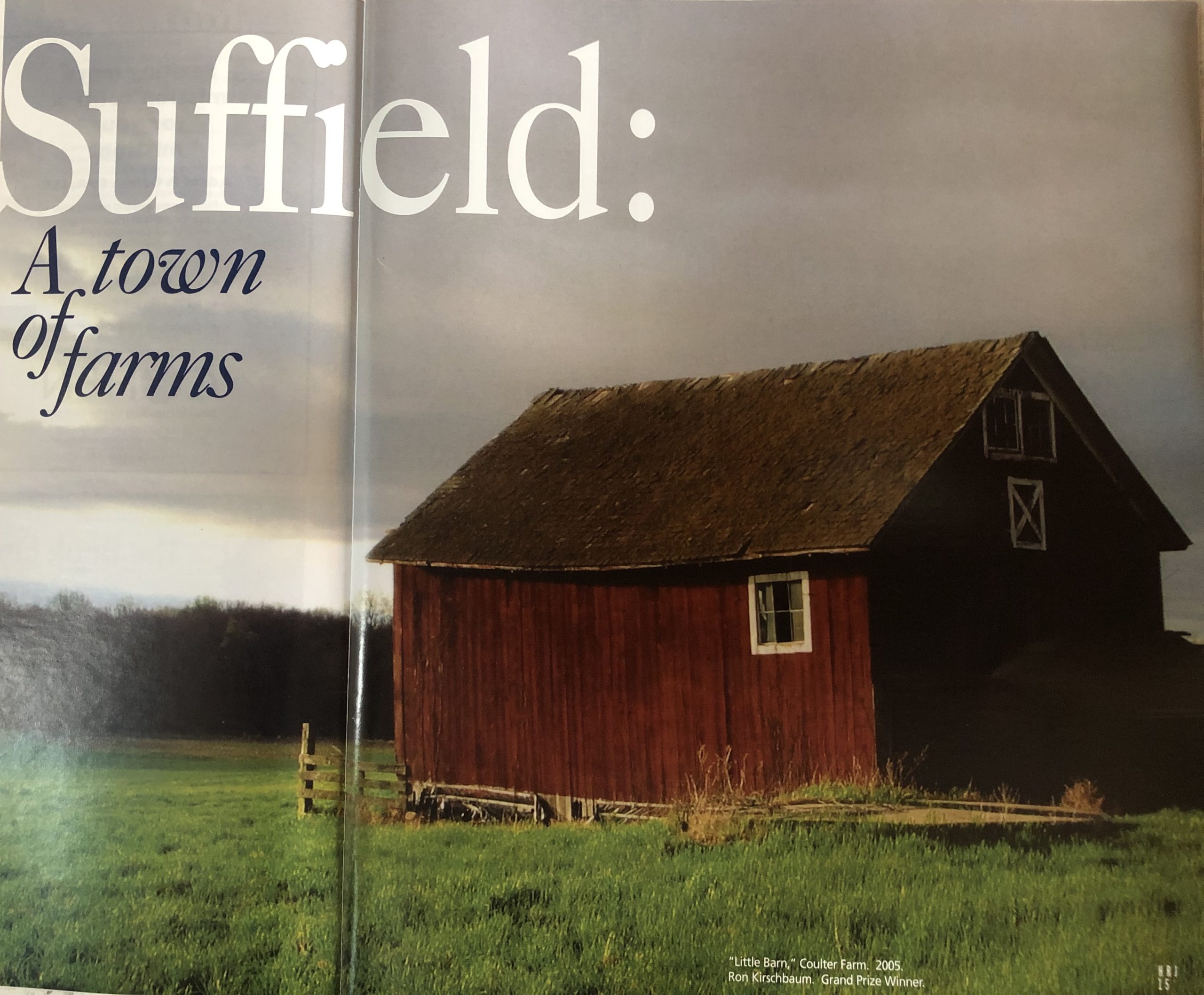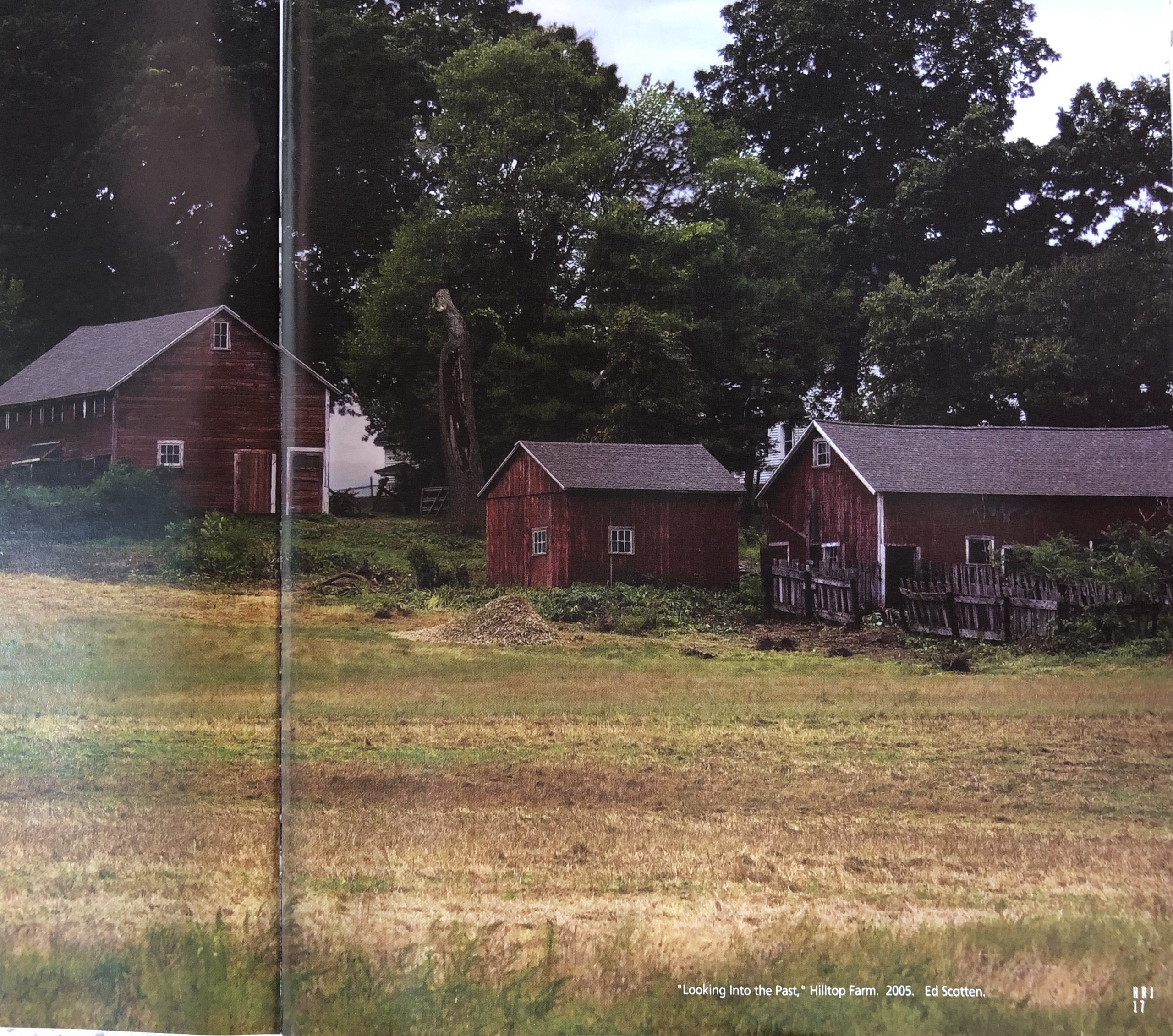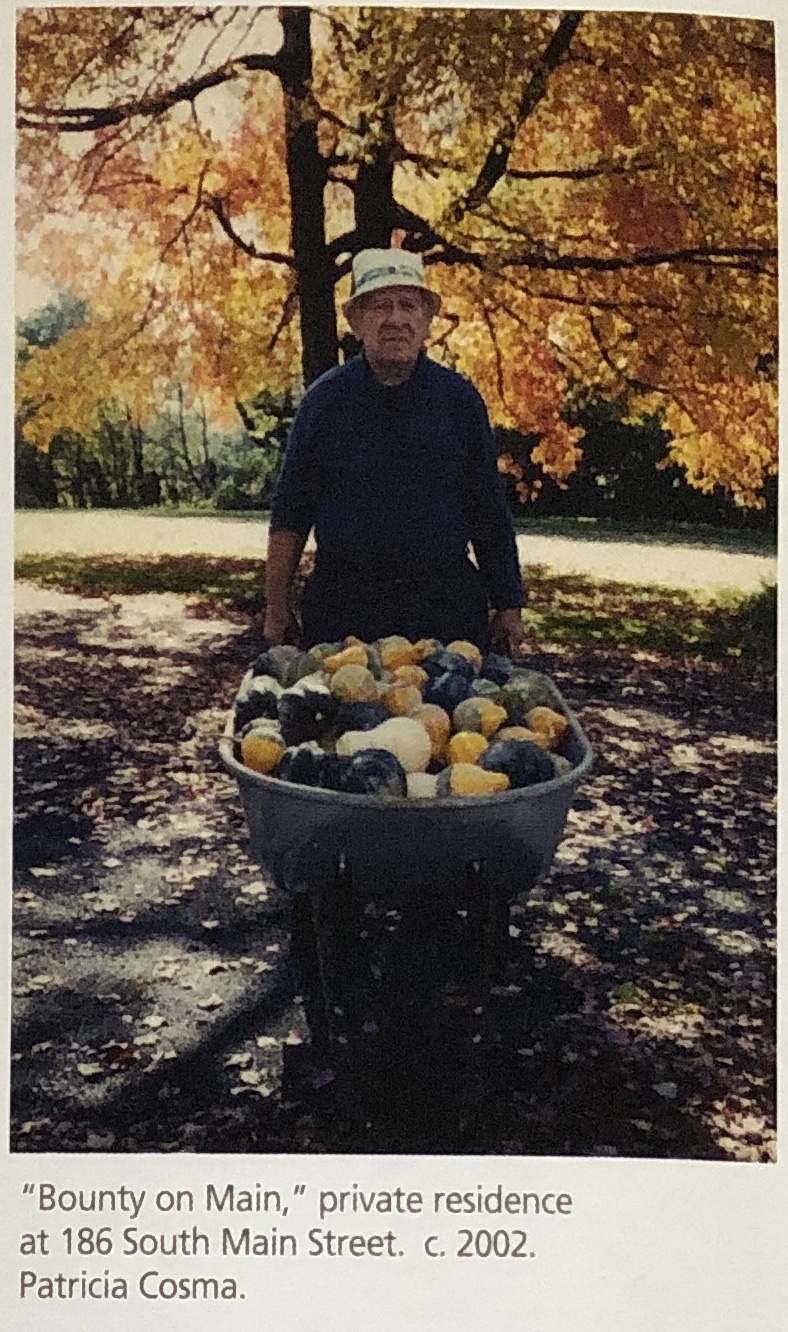By Laura Dillman
(c) Connecticut Explored Inc. Spring 2006
Subscribe/Buy the Issue!
As a tie-in with the statewide celebration of barns last year, Friends of the Farm at Hilltop, the Antiquarian & Landmarks Society (now Connecticut Landmarks) and Suffield Council for the Arts sponsored an amateur photography contest to capture images of agricultural life in Suffield. Seventy contest entries were received from 35 people ranging in age from 7 to 87, including 30 farmers who took photos of their farms. The entries were compelling and revealed a deep appreciation for farming and farm life in Suffield. A selection of the photos is presented here.
The town of Suffield has been largely devoted to farmland since the 1600s and boasts one of the highest concentrations of active farmland in the state (ten percent of the town’s land, down from almost a third just 40 years ago). Situated strategically along the west bank of the Connecticut River in north central Connecticut, Suffield benefits from the rich soil deposits left behind when glacial Lake Hitchcock receded. The area has been farmed for thousands of years, first by the native peoples who came to this region more than ten thousand years ago and later by European settlers.
A town of just 13,000 residents and 43 square miles, Suffield has more than 100 farms of various sizes, some more than 100 years old. Beaver Brook Farm has been in the Harrison family since 1647. Coulter farm started in 1877. Kuras Farm celebrated its 100th anniversary in September 2005.
Since the earliest days, tobacco has been the greatest single continuing commercial agricultural enterprise in town. But not every farmer in Suffield grows tobacco: many raise other non-food products such as horses, alpacas, Scottish highland cattle, oxen, turf grass, Christmas trees, and all manner of nursery stock. For this photo essay, however, we focus on farms raising edible produce: milk, eggs, honey, maple syrup, sheep, pigs, goats, guinea hens, pigeons, pheasants, turkeys, geese, rabbits, wine grapes, wheatgrass, squash, tomatoes, sweet corn, pumpkins, apples, pears, peaches, blueberries and raspberries.
Eight dairy farms are still active in town, two of them “dairy farms of distinction” as designated by the state Department of Agriculture for their overall appearance and the quality of their milk. There is also one certified organic farm.
Farm stands are plentiful and offer all the usual agricultural products, plus cheese, fudge, pies, cider, jams, jellies, and pickles as well as fresh-cut flowers and wreaths. Kuras Farm offers “pick your own” opportunities. The Suffield Farmers Market, established in 2001, operates every Saturday from June to October on the town green, from 9 a.m. to noon.
One special farm from Suffield’s past is finding new life. Along the river, the northeast corner of town, originally referred to as Great Hill, long lured farmers to its rich soils. Successive generations of the Sikes family worked the land from the 1600s to the 1900s. Between 1913 and 1925, George M. Hendee purchased 24 parcels of land around Great Hill and created Hilltop Farm, a grand country estate and gentleman’s farm of some 500 acres. Hendee was a co-founder in 1901 of Indian Motorcycle Company in Springfield, Massachusetts. He retired from Indian in 1916; Hilltop had been completed the year before. Hendee established a thriving dairy operation of prize-winning Guernsey cows housed in a 20,000-square-foot dairy barn. He also raised 10,000 white Leghorn chickens in an 8,000-square-foot “hen emporium” and 2,000 broiler hens, forerunners of today’s free-range chickens, that roamed the field seats of the large dairy barn and roosted in “colony houses” there. Charles Stroh bought the farm from Hendee in 1940 and raised prize-winning Holstein cows there until his death in 1992.
Eight houses on the Hilltop Farm property were occupied by the farm families — those of the manager, administrator, herdsman, poultryman, and farmhands. At one point, the children who lived on the farm were so numerous that they filled a school bus. The bulk of the farm’s products were sold to food service operations in hospitals, restaurants, and country clubs. The public could also come to Hilltop to buy fresh chicken, eggs, milk, and “buckets of gravy to pour over our biscuits,” as one former patron remembered. During the 1930s, the “Guernsey Cow”, a roadside food outlet featuring sandwiches and ice cream, was located in front of the massive Colonial Revival dairy barn along Mapleton Avenue. A menu from the period notes:
The Guernsey Cow is not a road stand. It is a place to stop for refreshing food and drink carefully prepared and daintily served either in the open or under cover and at reasonable prices. If pure dairy products are desired, they can be found at the Guernsey Cow, which is an annex to Hilltop Farm, Suffield, Connecticut, owned by George M. Hendee. It is the intent of the management of the Guernsey Cow to provide nothing but the highest grade food and drink at reasonable prices and served under ideal conditions in a pleasing manner. Drive in and be served in your car.
The modern barn will be open for inspection at all reasonable hours, and the cattle will be found most interesting to those who desire education as to the methods of scientific and clean milk production and who are looking for the full food value of unpasteurized milk.
Hendee’s grand residence, Hilltop Manor, was demolished in the early 1960s to make way for a seminary. Subdivided over time, the remnants of Hilltop are divided among several owners, including the town of Suffield, which holds 117 acres. The farm ceased poultry operations in 1985 and dairy operations in 1998. The Hilltop Farm Historic District was listed on the National Register of Historic Places on January 2005. The nonprofit group Friends of the Farm at HIlltop plans to return Hilltop to active farming and establish a community farm and educational center there. They are currently rehabilitating the large dairy barn.
Whether taking advantage of large distribution networks, selling from small farm stands, or simply growing food for family consumption, Suffield’s farms pepper the landscape and reflect a community character with deep roots in agriculture. Drive by and be served a wealth of visual and culinary delights.
 Laura Dillman is president of Friends of the Farm at Hilltop, Inc.
Laura Dillman is president of Friends of the Farm at Hilltop, Inc.
For more information on Hilltop Farm, visit www.fofah.com.





